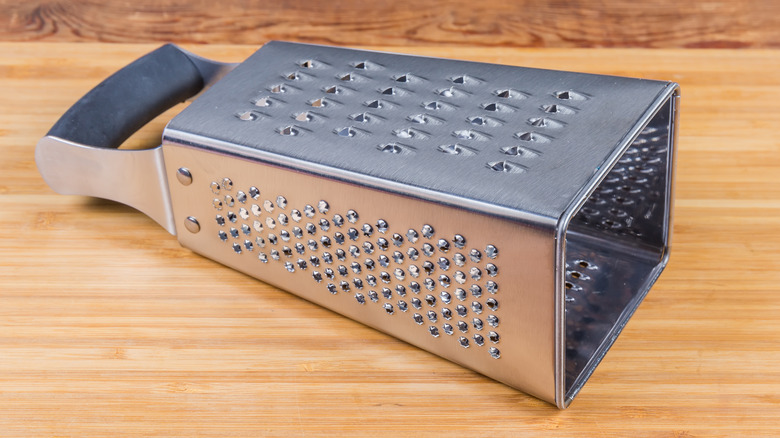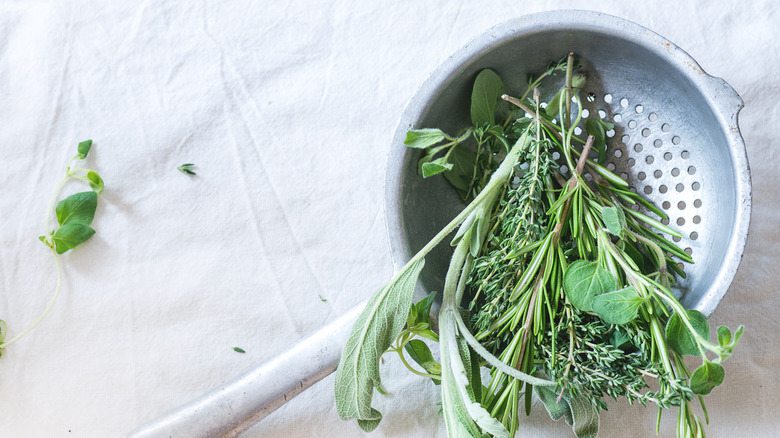The Cheese Grater Hack That De-Stems Herbs In A Swipe
Fresh herbs like cilantro, parsley, and thyme are some of the most valuable cooking staples you can stock in your fridge. Just a small pinch can add a delightful burst of flavor and color to balance out sweetness of desserts or add brightness to savory dishes. However, plucking the little leaves off of the stubborn stems can be a tedious task, to say the least.
If the long process of plucking fresh herbs is stopping you from buying them, know that you don't have to tackle them with your bare hands. There's an easier and less time-consuming way to strip off the leaves, and all it takes is a cheese grater. Just pull the stems of the herbs through the holes in the grater, and the sharp edges shear the leaves right off. The TikTok account @jeffandlaurenshow demonstrates this trick at the start of a compilation video of kitchen hacks.
@jeffandlaurenshow Helpful kitchen #hacks we love!❤️ #cookingathome #kitchenhacks #mealprep #hacks #LifeHacks #cooking #baking
For tender herbs like basil, parsley, or dill, you can even chop up the stems once you've removed the leaves and add them to dishes that benefit from their flavor, while disguising their texture. Quiches, pesto, and creamy dips are all great ideas. You can even stash your leftover stems to make homemade salad dressing. All of this being said, there are a few tips that can help you get the most out of the box grater trick, and also other convenient hacks for those of us who don't own this tool.
How to strip herbs off their stems using a cheese grater
Using a box grater to de-stem your herbs is simple: Prop the handy kitchen gadget up on a cutting board or your kitchen counter, then thread a stem of herbs through one of the holes, from the outside of the grater inward (and not the other way around). Just stick part of the stem through the hole, carefully reach inside the grater through the opening on top, and pull the rest of it through.
Be careful not to cut yourself when handling the grater, and keep it flat on the counter, so the leaves of the herbs fall right onto the surface instead of scattering through the air. You also need to make sure you use the proper hole size. Use the smaller holes on your grater for herbs with thin leaves, like tarragon or dill, and larger holes for hardier or larger herbs like cilantro, rosemary, and basil.
It's also possible to thread multiple stems of herbs through a large hole on the grater. Just be sure not to feed too many sprigs through at a time, so they don't get stuck. You could also bruise or squish more delicate herbs if you try to thread many stems through at once, so thread them one by one if you must — after all, it still beats picking them by hand.
Other easy ways to de-stem herbs
Don't have a box grater on hand? Fret not — there are many other kitchen tools you can use to prune your herbs more quickly. After you've thoroughly washed your herbs, grab a fork to strip the leaves off with ease. All you have to do is hold a bunch firmly in one hand, thread the stems through the tines in fork, and pull them through so the leaves get scraped off. It's similar to the box grater trick, if a bit fussier.
You can also use a colander to remove the leaves of thyme, oregano, and cilantro, among other herbs. Run the stems through one of the colander's holes, just as you would with a box grater. Use a mesh colander for thinner herbs or one with larger holes (such as a stainless steel variety) for thicker stems. In this case, you'll want to feed the stems through the inside and thread them towards the outside of the colander. This way, the leaves will collect in the bowl of the colander (but still do this over an extra bowl, in case the leaves fall through the colander!).
The holes of a colander are obviously not as sharp as those on a grater, so if all the leaves don't come off in one go, simply try again. You'll soon have a pile of herbs ready for garnishing or cooking directly into your meals, with very little effort spent.



